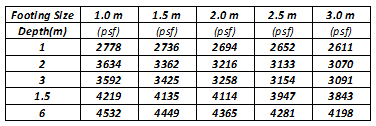SatoshiNakamoto09
Structural
Footing size 1.0m 1.50m 2.0m 2.5m 3.0m
Depth (m) (psf) (psf) (psf) (psf) (psf)
1 2778 2736 2694 2652 2611
2 3634 3362 3216 3133 3070
3 3592 3425 3258 3154 3091
4.5 4219 4135 4114 3947 3843
6 4532 4449 4365 4281 4198
Hello,
Im doing structural design, and for the design of foundation i got these values from the soil report(shown above).
Based on the bearing capacity evaluation indicated in the report, the geotechnical engineer used Hough Method(which is based on 25mm settlement) and using Skempton's ultimate net bearing capacit for fine grained soils.
I would like to ask any opinion from you if these results are quite acceptable? or is it possible to get lower bearing capacity as the suggested footing size to be used becomes larger?
I got 2 soil reports already from this geotechnical engineer but 2 different projects and it has similar results which is SBC decreases as footing size suggestion increases.

Depth (m) (psf) (psf) (psf) (psf) (psf)
1 2778 2736 2694 2652 2611
2 3634 3362 3216 3133 3070
3 3592 3425 3258 3154 3091
4.5 4219 4135 4114 3947 3843
6 4532 4449 4365 4281 4198
Hello,
Im doing structural design, and for the design of foundation i got these values from the soil report(shown above).
Based on the bearing capacity evaluation indicated in the report, the geotechnical engineer used Hough Method(which is based on 25mm settlement) and using Skempton's ultimate net bearing capacit for fine grained soils.
I would like to ask any opinion from you if these results are quite acceptable? or is it possible to get lower bearing capacity as the suggested footing size to be used becomes larger?
I got 2 soil reports already from this geotechnical engineer but 2 different projects and it has similar results which is SBC decreases as footing size suggestion increases.


